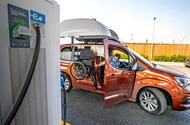The rollout of electric vehicle (EV) charging infrastructure in the UK is facing significant challenges, particularly when it comes to accessibility for disabled drivers. A recent parliamentary report has raised serious concerns about the lack of compliance with new standards designed to make charging points more user-friendly for those with disabilities. The findings highlight a critical oversight in the transition to electric mobility, suggesting that the needs of disabled drivers are being overlooked in this rapidly evolving landscape.
What Are the Key Issues for Disabled Drivers?
The Public Accounts Committee’s report paints a troubling picture: out of approximately 15,000 rapid and ultra-rapid charging points across the UK, none fully meet the BSI PAS 1899 standards. These standards were developed to enhance the charging experience for disabled users, ensuring that chargers are not only accessible but also safe to use. Unfortunately, many existing charging stations are hindered by physical barriers, such as kerbs and obstructions, making it difficult for wheelchair users to navigate.
Moreover, the weight of charging cables and the force required to connect them can be a significant barrier for those with limited strength or mobility. The report notes that by 2035, an estimated 1.35 million drivers with disabilities will rely on public charging points, underscoring the urgency of addressing these accessibility issues.
How Are Charging Providers Responding?
In light of these findings, advocacy groups like the Motability Foundation are calling for a more proactive approach from charging providers. While the foundation supports the report’s conclusions, it acknowledges the difficulty in verifying the exact number of compliant charging points due to a lack of data collection on accessibility. However, they agree that the current number is likely quite low.
Some companies are taking steps to improve accessibility. For instance, Instavolt recently opened a new ultra-rapid charging site in Hampshire, featuring larger bays and enhanced maneuvering space for wheelchair users. This site includes payment terminals and screens positioned at accessible heights, along with swing arms that support the weight of charging cables. Such innovations are a step in the right direction, but they also highlight the need for widespread adoption of similar standards across the network.
What About Geographic Disparities?
The report also raises concerns about the geographic distribution of charging points, noting that a staggering 43% of the UK’s charging infrastructure is concentrated in London and the southeast. In contrast, regions like the northeast and southwest are severely underserved, with fewer rapid chargers available. This uneven distribution raises questions about equity in access to EV charging, particularly for drivers in rural areas who may find it less commercially viable for operators to install charging stations.
The report emphasizes that without addressing these regional disparities, the rollout of charging points risks perpetuating inequalities among different groups of drivers. As it stands, many major roads in England’s southwest and north lack sufficient rapid charging options, which could hinder the adoption of electric vehicles in those areas.
What’s Next for the Charging Infrastructure?
Despite the challenges highlighted in the report, organizations like ChargeUK, which represents charging companies, argue that the rollout is actually ahead of demand. However, they acknowledge facing various delivery barriers that slow down the process. The Department for Transport (DfT) insists that progress is being made, with a new charging point added to the network every 29 minutes. Yet, the report notes that a significant portion of the £950 million Rapid Charging Fund remains unspent, raising questions about the government’s commitment to enhancing the infrastructure.
Experts like Melanie Shufflebotham, CEO of ZapMap, recognize that while the overall number of charging points has increased in line with the growing number of EVs, local and regional disparities remain a pressing concern. Areas like Wales and Northern Ireland are lagging behind, which could further complicate the transition to electric mobility for drivers in those regions.
The big takeaway? The rollout of EV charging infrastructure isn’t just about expanding numbers; it’s about ensuring that every driver, regardless of ability, can access the charging they need. Addressing these challenges will require collaboration between government bodies, charging providers, and advocacy groups. By focusing on smarter adjustments and prioritizing accessibility, we can create a more inclusive future for all drivers. Start with one change this week, and you’ll likely spot the difference by month’s end.

